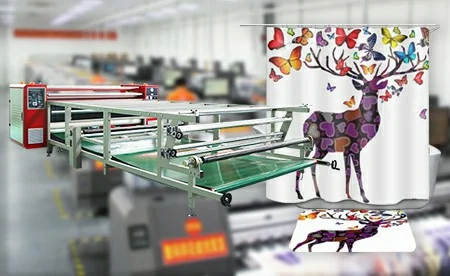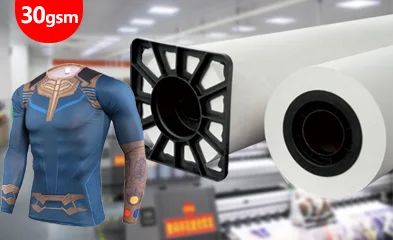HOT SALE
APPLICATION
Phone:+86-15215969856 E-Mail: 396838165@qq.com
Sublimation printing totally shakes up how you make bright, durable designs on fabrics and hard stuff like ceramics. Getting that flawless print, though? It’s not just about cool inks or a solid printer. The heat transfer paper you pick is super important. It can make colors stand out and keep details sharp. This guide digs into why sublimation paper is such a big deal and helps you choose the best one for awesome, pro-quality results every time.
The Fundamentals of Sublimation Printing
Sublimation printing has totally changed how pros handle decorating fabrics and hard surfaces. It churns out bright, lasting images without messing up the material. Pretty cool, right? But to get steady, awesome results, it’s not just about good inks or printers. You gotta have the right heat transfer paper for sublimation. This guide dives into why that paper is such a big deal and how to pick the perfect one for your projects.
The Science Behind Sublimation Transfer
Sublimation is all about a cool chemical trick. Solid dye particles turn straight into gas when you hit them with heat and pressure. No liquid stage at all! Those gas dyes then stick tight to polyester fibers or special coated surfaces, making a long-lasting image. The key to nailing this process? It’s how well the transfer paper holds and lets go of the dye.
Key Components in the Sublimation Process
For a great sublimation print, you need four main things: sublimation ink, the material you’re printing on, a printer, and transfer paper. Each one plays a part in making the print look good. But the paper? It’s like the middleman. It grabs the ink during printing and releases it cleanly when you press with heat. Super important!
Role of Heat Transfer Paper in Image Fidelity
The transfer paper’s coating must hold ink precisely until it’s activated by heat. If the coating is subpar or inconsistent, colors may bleed or appear washed out. A high-quality paper ensures that images retain their sharpness and vibrancy after transfer.
Critical Attributes of High-Performance Heat Transfer Paper
To maximize precision and color accuracy in sublimation printing, your choice of transfer paper must meet several technical standards.
Coating Quality and Ink Absorption Efficiency
The coating on the paper decides how well it grabs ink drops when you print. A nice, even coating keeps images sharp without any smudging or blurry ghosting. That 30gsm Non-Tacky Sublimation Heat Transfer Paper? It gives you photo-quality prints, dries super fast, and is totally waterproof to boot.
Dimensional Stability Under Heat and Pressure
During pressing at temperatures around 180–200°C, papers can warp or shrink if they lack thermal stability. This distortion leads to misalignment or blurred graphics. Professional-grade papers are engineered to maintain their dimensions under stress.
Compatibility With Different Substrates and Inks
Not all papers work well across printers or substrates. You must ensure compatibility with your ink type—especially when using high-density sublimation inks—and your chosen fabric or hard surface material.
How Heat Transfer Paper Affects Print Precision
Precision isn’t just about resolution—it’s about how faithfully your design transfers from screen to substrate.
Impact on Color Accuracy and Gradient Reproduction
A poorly coated paper can absorb too much ink or release it unevenly during pressing, distorting gradients and hues. Our sublimation transfer paper can use different brands sublimation ink to print, like Epson, Inbank, Tianwei, Kiian, ensuring color fidelity across a broad spectrum.
Influence on Line Sharpness and Edge Clarity
When line work matters—such as in logos or technical illustrations—the right transfer medium prevents feathering at edges. This is where specialized coatings make a real difference in maintaining clarity post-transfer.
Evaluating Changfa Digital’s Heat Transfer Papers for Professional Use
If you’re seeking consistent performance across production runs, choosing a reliable supplier becomes essential. That’s where Changfa Digital stands out—not only as a manufacturer but also as an innovation leader.
Changfa Digital are a professional sublimation paper manufacturer and has been supplying digital printing service for 15+ years, it’s a factory for sublimation papers, from base paper to making coating and slitting and shipping to all of the world. Changfa Digital products are tested rigorously under varied temperature conditions—from rapid 8-second presses at 165°C to prolonged durations—to ensure stability across workflows. Transfer temperature: 150C; Transfer time: 15s showcases adaptability across equipment types.
Application Scenarios Where Precision is Critical
Certain industries demand more than just good results—they require perfection every time.
Sportswear and Performance Apparel Printing
Athletic garments often feature complex patterns on stretchy materials like polyester-spandex blends. The precision required here makes premium papers non-negotiable for edge definition and colorfastness.
Textile materials after transferring: Sunproof Level 6; Washproof Level 4-5. This durability ensures longevity even after multiple washes.
Hard Substrate Applications
From mugs to aluminum panels used in signage or décor, hard substrates require exact alignment during pressing due to their inflexible nature. Here again, dimensional stability of your chosen heat transfer medium becomes essential.
Workflow Optimization Using Changfa Digital’s Sublimation Papers
Consistency isn’t just about output—it also affects efficiency in production environments where time equals cost.
Reducing Waste Through Accurate First-Time Transfers
Misprints cost money—not only in wasted materials but also labor hours. Hot Sales 30Gsm Non-Tacky Sublimation Heat Transfer Paper minimizes these risks thanks to its smooth surface that avoids jams or ink dragging during print cycles. The paper surface is smooth without paper jam and ink dragging.
Enhancing Throughput Without Compromising Print Quality
Fast drying times allow immediate handling post-printing—no waiting around—which means faster turnaround per job while maintaining high-end visual fidelity. High effective, color keep for long years
Factors to Consider When Selecting a Heat Transfer Paper
Beyond brand reputation lies technical fit—choosing what works best with your setup ensures optimal results every time.
Matching Paper Type
Ensure that your printer model supports roll widths offered by suppliers—we can make the width of the range :61cm,91.4cm,110cm,152cm… Also verify compatibility with high-density inks if you’re producing deep blacks or rich gradients frequently.
Environmental Conditions Practices
Paper absorbs moisture from the air quickly if not stored properly; this affects both printability and final result consistency. Always store rolls upright in climate-controlled rooms sealed within original packaging until use. Standard export package, use the core cap with pallets.
Recommendations for Professionals in Sublimation Printing
For those working in demanding environments—from sportswear customization to industrial signage—the choice of heat transfer media can define the success or failure of entire projects. If you’re looking for an edge in both performance consistency and technical support globally available around-the-clock, Changfa Digital offers more than just products—it delivers solutions backed by decades of expertise.
FAQ
Q: What makes non-tacky sublimation heat transfer paper ideal for textile printing?
A: Non-tacky variants prevent ghosting by avoiding unnecessary adhesion post-transfer while maintaining sharp image registration—ideal for soft fabrics like polyester blends used in sportswear.
Q: Can I use any printer with this type of heat transfer paper?
A: Yes—as long as it’s an inkjet printer compatible with sublimation inks such as Epson or Mimaki models. Our sublimation transfer paper can be used in any type of inkjet printer (Epson, Mutoh)…
Q: How do I ensure the longevity of my transferred designs?
A: Choose papers that support durable inks rated for sunproof level 6 and washproof level 4–5; Textile materials after transferring: Sunproof Level 6; Washproof Level 4–5, along with proper curing temperatures during pressing sessions.









